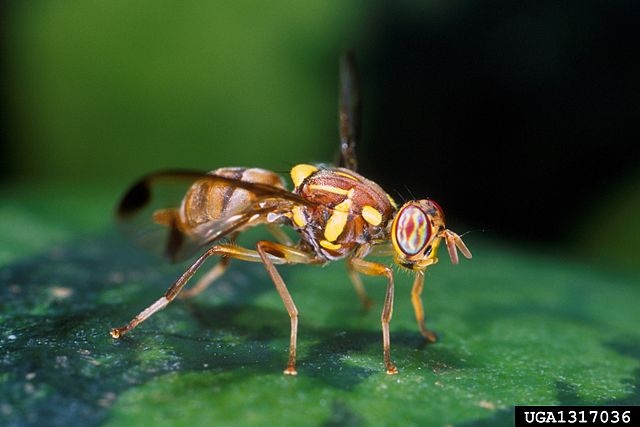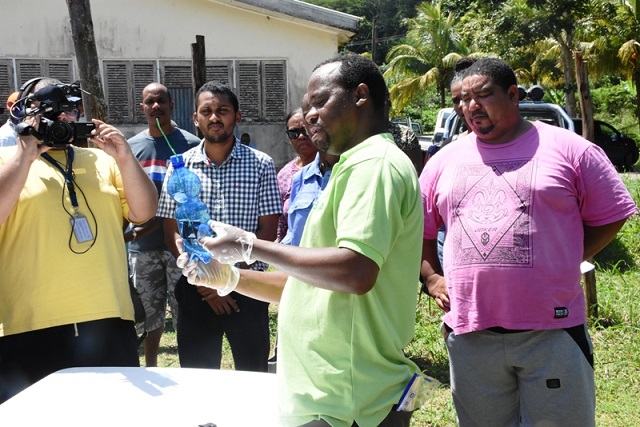Targeting fruit flies in Seychelles to save melons, pumpkin and cucumbers

The melon fly is a pest that affects the production of cucurbit, a plant of the gourd family, which includes melon, pumpkin, squash and cucumber. (Scott Bauer, USDA Agricultural Research Service) Photo License: CC-BY 3.0
(Seychelles News Agency) - Seychelles is relaunching a project to reduce the number of fruit flies, a pest that is currently affecting the production and yield of certain crops. The project will prepare the grounds for farmers to start increasing fruits and vegetables productions, an official said.
The chief plant biosecurity officer of the National Biosecurity Agency, Keven Nancy, told SNA that the project is in line with the comprehensive agricultural development plan of the 115-island archipelago of the Western Indian Ocean.
“We plan on increasing agricultural production and if you are to do so with the presence of melon flies, it will be a useless battle. First, you need to control the pest and then increase production,” explained Nancy.
The Seychelles’ Ministry of Agriculture and Fisheries is working in collaboration with the International Atomic Energy Agency (IAEA) to carry out the project. The ministry is providing the funding required to put in place all the logistics while IAEA is providing the necessary equipment and materials, as well as the experts.
Registered farmers in Seychelles are receiving equipment and materials to control the pest for free.
“We want farmers to take ownership of the programme and hence we are showing them all the techniques of control which includes sanitation, setting traps, setting baits and installing MAT (Male Annihilation Technique) blocks,” said Randy Stravens, the IAEA National Project Counterpart.
 |
| Farmers and others watching a demonstration on how to make makeshift traps using plastic bottles and a MAT block to be hanged around their farms. (Seychelles Nation) |
Introduced in the Seychelles in November 1999, the melon fly, Bactrocera cucurbitae, is a pest that affected the production of cucurbit, a plant of the gourd family, which includes melon, pumpkin, squash and cucumber.
“With the introduction of the pest, a lot of farmers who were producing cucurbit found themselves in a difficult situation and had to switch to producing root crops. In a survey we carried out during that time, we found that around 80 to 90 percent of farmers made the switch,” said Stravens.
The relaunching of the project also came after the biosecurity agency had noticed an increase in the melon fly population. In the agricultural community of Val D’en D’or alone, the agency was recording 27 flies per trap per day, which is twice as high as what the officials were expecting.
“Our target is to bring down the numbers as low as one fly per trap per day. This will allow us to integrate the Sterile Insect Technique (SIT). If we do not reach one fly per trap per day, we won’t be able to introduce SIT as it won’t have any effect,” said Stravens.
The Sterile Insect Technique involves the rearing of fruit flies in a laboratory and once reaching the pupa stage, the flies are sterilised through the use of radiation. These flies are later released into the wild, where they mate with the wild ones. Since these flies are infertile, the female flies will not lay any egg causing the population to decrease.
In places where there are no farmers, the National Biosecurity Agency, together with the Seychelles Agricultural Agency, is responsible for treating the area and getting rid of the flies.
“People who are engaged in backyard gardening and has a fruit fly problem, they can contact us, and we will give them the proper advice they can apply in their garden. The methods that they will use involve no chemical, which includes setting up traps and having good sanitation,” said Stravens.
He added that the project will help Seychelles to boost the current biosecurity level.
“Seychelles imports a lot of fruits and vegetables and as such, the risk that another foreign species is introduced is high. In the region, we are doing a good job as compared to Mauritius and Reunion, as we have only two fruit fly species whereas they have over 10 species,” said Stravens.
The baiting and trapping techniques are helping to control both species of fruit flies in Seychelles, where are MAT and SIT affect only the targeted species.





